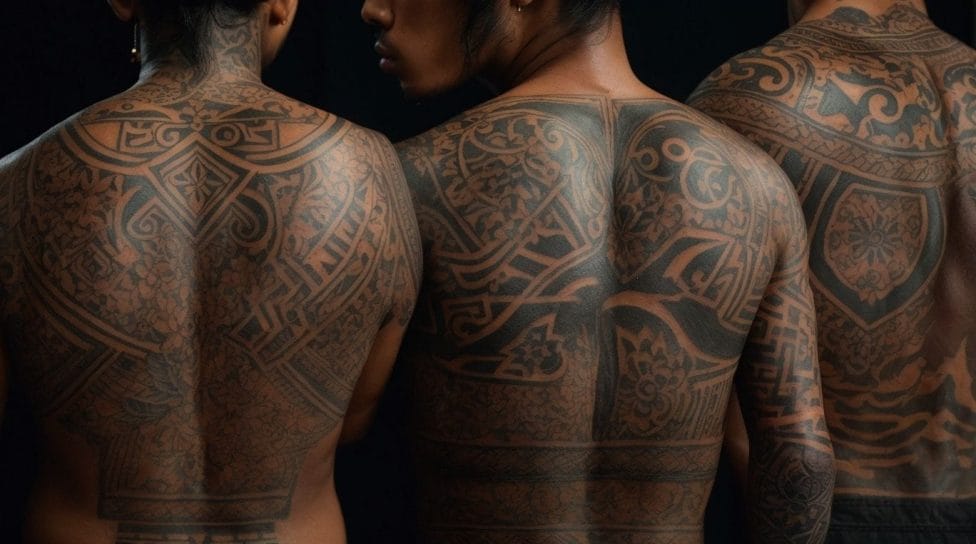Tattoos have a long and rich history, dating back thousands of years. The origins of tattoos can be traced back to ancient cultures worldwide. Each culture has its unique perspective on Tattooing and its significance. Understanding the history and cultural perspectives can provide insight into the evolution and popularity of tattoos today.
The history of tattoos is an intriguing topic, as it sheds light on the practices and beliefs of ancient civilizations. Evidence of tattoos can be found in ancient cultures, such as the Egyptians, East Asians (China, Japan, and Korea), Polynesians, and Native Americans. These cultures used tattoos for various purposes, including religious and spiritual significance, social status, rites of passage, and personal expression.
The origin of tattoos from a cultural perspective offers a fascinating glimpse into the diverse practices across different societies. In ancient Egypt, tattoos were associated with religious rituals and served as a symbol of protection or identification. In East Asia, tattoos had decorative and spiritual meanings, symbolizing strength, courage, and protection. Polynesians used elaborate tattoos as a form of storytelling and to represent their genealogy. Native Americans utilized tattoos for various purposes, including tribal identification, personal achievements, and spiritual beliefs.
The evolution of tattoos showcases the changing perceptions and practices surrounding this ancient art form. Tattoos have evolved from simple designs to intricate pieces of body art. Technological advancements, such as the development of tattoo machines, have made the process safer and more efficient. Tattoos have become more mainstream, with greater acceptance in society.
The popularity of tattoos today can be attributed to several factors. Mainstream acceptance of tattoos as a form of self-expression has increased, breaking societal stigmas. Tattoo trends and styles continually evolve, with new techniques and designs emerging. From minimalist tattoos to realistic portraits, people have a wide range of options.
Exploring the origin, evolution, and popularity of tattoos provides a deeper understanding of their cultural significance and the reasons behind their enduring appeal. Whether for personal expression, cultural connection, or artistic appreciation, tattoos continue to leave their mark on individuals and society.
Key takeaway:
- Tattoos have been present in ancient cultures: Evidence of tattoos has been found in various ancient civilizations, including Ancient Egypt, East Asia, Polynesia, and Native American tribes.
- Tattoos have evolved: Tattoos have changed in terms of styles, techniques, and societal acceptance throughout history, reflecting cultural shifts and individual expression.
- Tattoo popularity continues to grow: Tattoos are now widely accepted in mainstream society, with various tattoo trends and styles emerging, reflecting the diverse tastes and preferences of individuals today.
History of Tattoos

Photo Credits: Tattooineplanet.Com by Jeffrey Clark
Tattoos have a fascinating history dating back thousands of years. The history of tattoos is rich and diverse, originating in various ancient cultures worldwide with different purposes and meanings. In ancient Egypt, tattoos were not only fashionable but also symbolic of wealth and status. Similarly, in Japan, tattoos served both spiritual and decorative purposes, reflecting the deep cultural significance attached to them. In Polynesia, tattoos were deeply rooted in the culture and tradition of the people, carrying immense meaning and symbolism.
Today, tattoos have evolved into a popular form of self-expression and art. They allow individuals to showcase their stories, beliefs, and passions through ink. If you want to delve deeper into the history of tattoos, I recommend exploring ancient art and texts that shed light on their origins and significance. Additionally, visiting museums that showcase historical tattoo artifacts can provide further insights into the evolution and cultural importance of tattoos throughout history.
Is There Evidence of Tattoos in Ancient Cultures?
Is there ample evidence of tattoos in ancient cultures?
Certainly, there is ample evidence of tattoos in ancient cultures, spanning various regions and periods. For example, ancient Egyptian mummies have been found with tattoos on their bodies, believed to be symbols of status or religious significance. In East Asia, there is the Japanese tradition of irezumi that dates back thousands of years with intricate designs reflecting social status and personal beliefs. Polynesians also have a rich history of Tattooing, demonstrating the use of symbols and patterns to tell stories and represent important milestones. Native Americans also practiced Tattooing, often using natural pigments and designs that held cultural and spiritual meanings. Thus, these ancient cultures provide a fascinating insight into the prevalence and significance of tattoos throughout history.
Origin of Tattoos: Cultural Perspectives

Photo Credits: Tattooineplanet.Com by Adam Nguyen
The rich history of tattoos stretches across various cultures, each with its unique perspective. Join us as we dive into the origin of tattoos through different cultural lenses. From Ancient Egypt’s symbolic ink to East Asia’s intricate designs and Polynesia’s tribal expressions to Native Americans’ spiritual body art, we’ll uncover the fascinating narratives behind these cultural perspectives. Prepare to be captivated by the diverse and profound origins of tattoos.
Ancient Egypt
Ancient Egypt is one of the earliest known cultures to practice Tattooing. The art of tattooing in Ancient Egypt was closely associated with religious and spiritual beliefs. Tattoos were often used as symbols of protection and served as amulets. They were used to honor gods, mark social status, and symbolize spiritual enlightenment. The evidence of tattoos in Ancient Egypt can be found on mummies and in ancient artwork. It is fascinating to see how Tattooing has evolved from its origins in Ancient Egypt to the diverse and popular art form it is today.
Fun fact: The oldest tattooed female mummy, “Amunet,” was discovered in Egypt and dates back to around 2160 BC.
East Asia
has a rich history of tattooing that dates back thousands of years. In ancient times, tattoos in East Asia were seen as a form of self-expression and a symbol of social status. Tattoos were commonly found among indigenous tribes, such as the Ainu in Japan and the Atayal in Taiwan. These tattoos often depicted cultural beliefs, spirituality, and protection. Today, East Asia has a vibrant tattoo culture, with modern designs incorporating traditional motifs and techniques. Fun fact: The word “tattoo” is derived from the Tahitian word “tatau,” which means “to mark.
Polynesia
played a significant role in the history and development of tattoos. Polynesian tattoos are deeply rooted in their culture and traditions, each with its symbolic meaning. The art of tattooing in Polynesia dates back thousands of years, and it was considered a sacred practice. Tattoos depict social status, family lineage, and spiritual beliefs. They were also seen as a rite of passage and a way to connect with their ancestors. Today, Polynesian tattoos continue to be admired and sought after for their detailed designs and cultural significance. Fun fact: “tattoo” originates from the Polynesian word “tatau.”
Native Americans
Native Americans have a rich history of tattooing that dates back thousands of years. Tattoos held cultural significance for Native American tribes, serving as symbols of identity, status, and spirituality. Each design conveyed specific meanings, such as tribal affiliation or personal achievements. Native American tattoos often incorporated elements of nature, such as animals or feathers, to honor their connection to the land and its resources. Today, Native American Tattooing is an important part of their cultural heritage, preserving traditions and sharing their stories with the world.
Fun Fact: Native American tribes like the Maori of New Zealand are known for their intricate and highly symbolic tattoo artistry.
Evolution of Tattoos

Photo Credits: Tattooineplanet.Com by Jesse Garcia
Tattoos have a fascinating evolution of thousands of years, showcasing the ever-changing tastes and preferences of individuals worldwide. Throughout different cultures, ancient civilizations like Egyptians and Polynesians were the pioneers in practicing tattoos for religious or cultural purposes. However, the significance of tattoos has transformed over time from symbols of status or spirituality to expressions of self and individuality. Today, the ongoing evolution of tattoos is marked by advancements in tattooing techniques, ink quality, and the availability of diverse designs. Whether it’s traditional tribal tattoos or modern minimalist designs, embracing this ancient art form allows you to be a part of the rich history and continuous evolution of tattoos. For more information on the origins of tattoos, check out the Where Did Tattoos Originate?
How Did Tattoos Change Over Time?
Tattoos have changed significantly over time, reflecting cultural shifts and technological advancements. The evolution of tattoos can be seen in various aspects:
1. Techniques: Over time, there has been a remarkable transformation in tattooing techniques. Traditional tattoos were created using crude tools like bones or thorns, resulting in simple, basic designs. However, with the introduction of electric tattoo machines, modern tattooing techniques have become prevalent. These machines have revolutionized the art of Tattooing, allowing artists to create more intricate and detailed artwork.
2. Styles: The styles of tattoos have experienced a notable shift throughout history. In the past, tattoos mainly consisted of basic black ink designs. However, with advancements in tattooing skills and the influence of different art movements, there has been a broad expansion in tattoo styles. Nowadays, you can find various styles, including realism, watercolor, and geometric patterns. For more information on the history of Tattooing, check out Where Did Tattoos Originate?
3. Cultural Significance: The cultural meaning behind tattoos has also changed over time. Previously, tattoos were associated with specific tribal or spiritual practices. However, in the present era, tattoos have transformed into a form of self-expression and personal storytelling. People now use tattoos to convey their individuality and share their unique stories.
4. Acceptance: The level of social acceptance surrounding tattoos has undergone a significant transformation. Historically, tattoos were often linked to criminality or rebellion and were stigmatized by society. Nevertheless, in recent years, tattoos have gained widespread acceptance in mainstream society. This shift in acceptance has led to a greater diversity of tattooed individuals and a wider range of tattoo styles.
The changes in tattooing over time reflect artistic innovation, cultural shifts, and societal acceptance. As cultural attitudes and technology evolve, the art of Tattooing will undoubtedly continue to adapt and progress.
The Popularity of Tattoos Today

Photo Credits: Tattooineplanet.Com by Zachary Rivera
Tattoos have come a long way from being associated with counter-culture. Today, they have gained widespread popularity and acceptance. In this section, we’ll uncover the reasons behind the mainstream embrace of tattoos. From exploring the latest trends and styles to discussing the impact of popular culture, get ready to delve into the fascinating world of tattoos today.
Mainstream Acceptance
In recent years, there has been a significant growth in the mainstream acceptance of tattoos. What was once considered taboo, tattoos are now widely accepted in many societies. The increasing acceptance can be attributed to various factors, including shifts in societal norms and the strong influence of popular culture. Moreover, the endorsement of tattoos by celebrities and public figures has greatly contributed to their mainstream acceptance. Additionally, the advancements in tattoo technology and the emergence of skilled tattoo artists have led to the creation of more intricate and visually appealing designs, thereby further solidifying tattoos’ acceptance in mainstream society.
Tattoo Trends and Styles
Tattoo Trends and Styles have evolved significantly, reflecting cultural shifts and personal expressions. Some popular tattoo trends and styles include:
- Minimalist tattoos: Simple, delicate designs emphasizing clean lines and minimal details.
- Watercolor tattoos: Vibrant and artistic designs that mimic the appearance of watercolor paintings.
- Geometric tattoos: Precise and symmetrical patterns that create geometric shapes and symbols.
- Script tattoos: Elegant and intricate lettering, often featuring meaningful quotes or words.
- Realism tattoos: Highly detailed and lifelike depictions of people, animals, or objects.
True story: A friend of mine got a minimalist tattoo of a small bird on their wrist. It symbolized freedom and served as a constant reminder to embrace life’s opportunities. The simplicity of the design perfectly captured their personality and style.
Some Facts About Where Tattoos Originate:
- ✅ Tattoos have been practiced across time and cultures for various reasons, such as religious beliefs, protection, love declarations, and punishment. (Source: Smithsonian Magazine)
- ✅ The origin of Tattooing is believed to have evolved from scarification rituals, bloodletting practices, medical treatment, or by chance. (Source: Our Team)
- ✅ The earliest evidence of tattoo art comes from clay figurines in Japan dating back to 5000 BCE. (Source: Our Team)
- ✅ The oldest preserved tattoos on human skin belong to ‘Ötzi the Iceman,’ a Bronze-Age man from around 3300 BCE, who had 57 tattoos. (Source: Our Team)
- ✅ Tattooing has been practiced worldwide since ancient times, with examples found in various locations, including Greenland, Egypt, China, and the Andes. (Source: Wikipedia)


